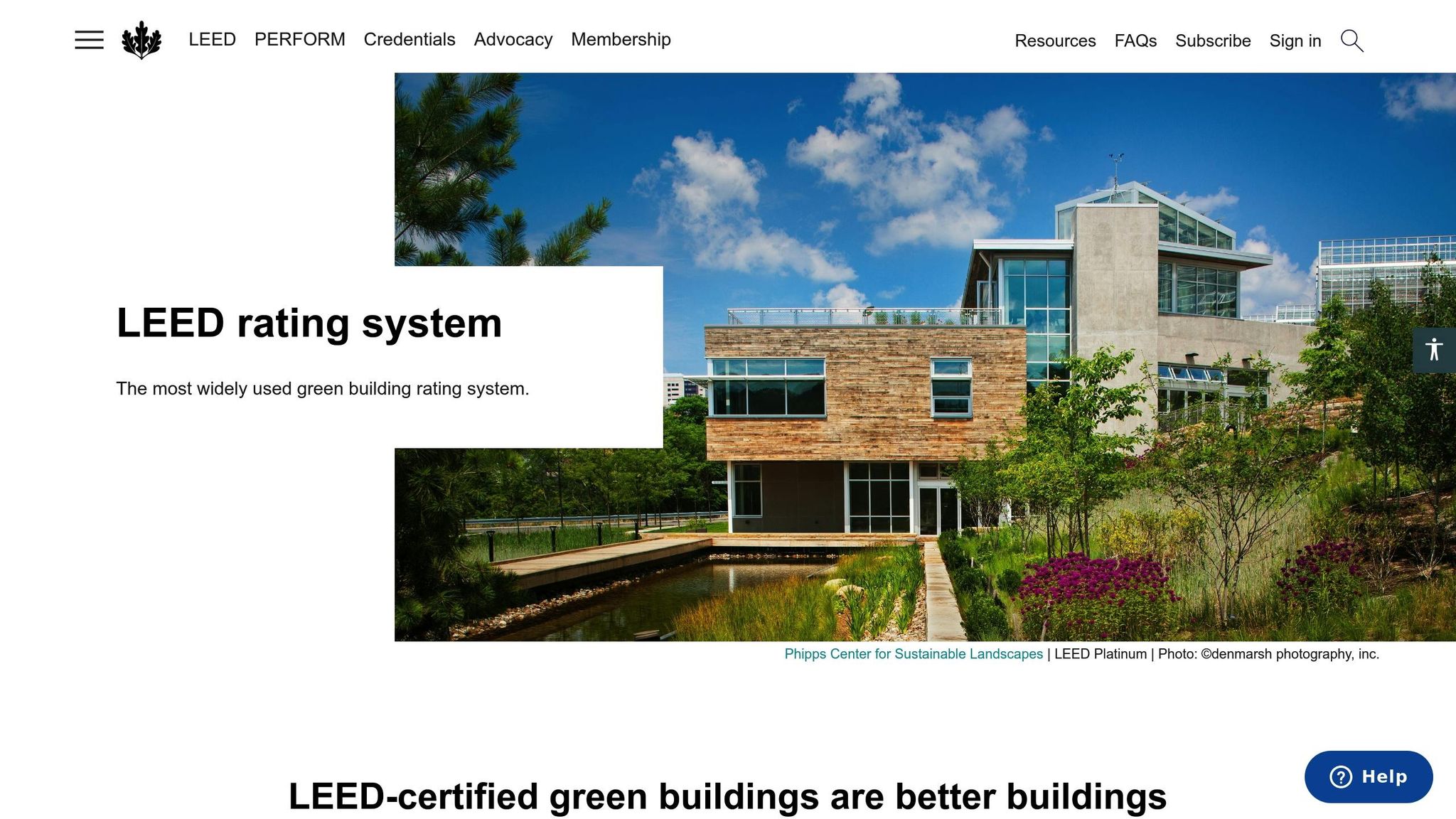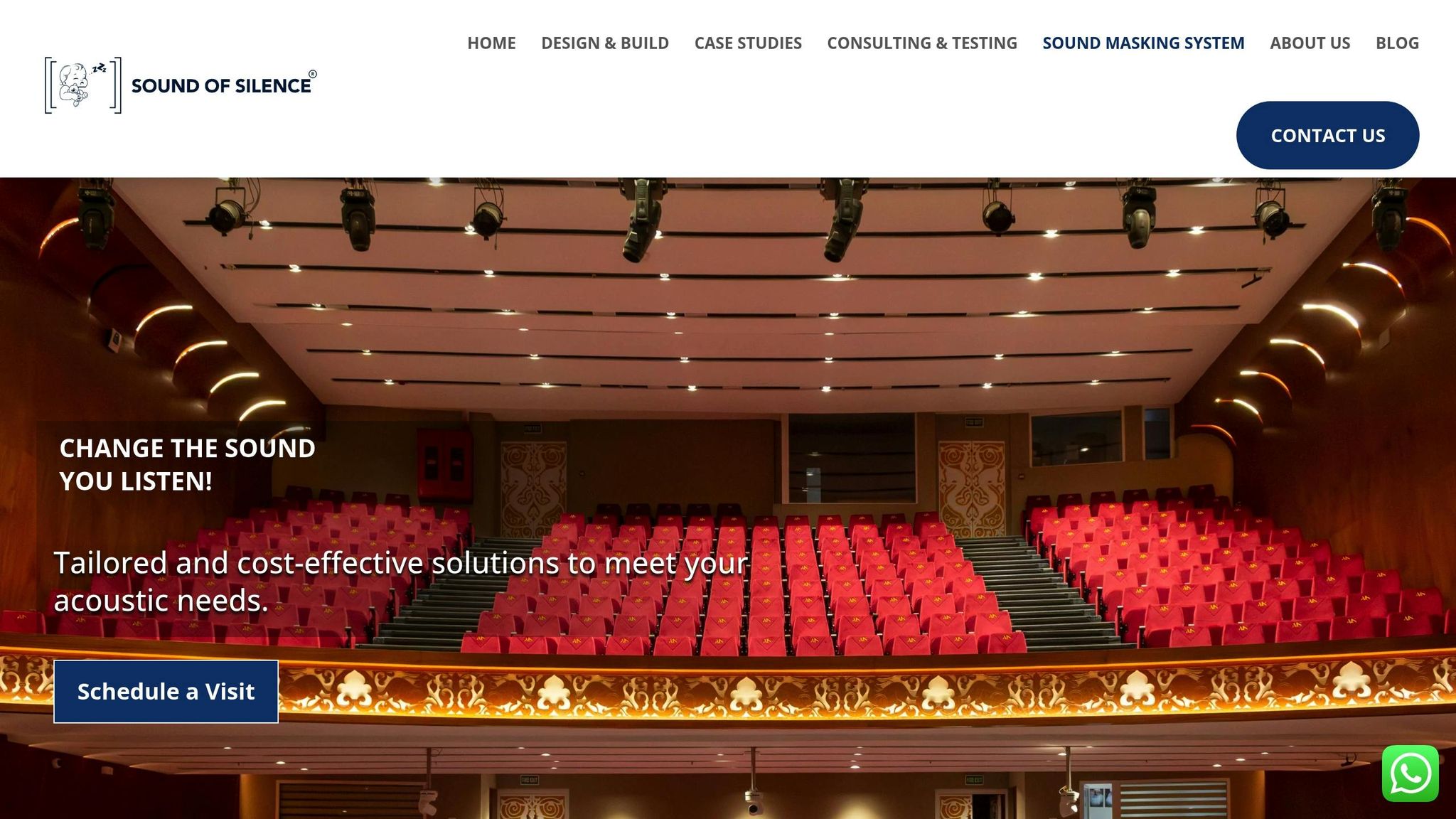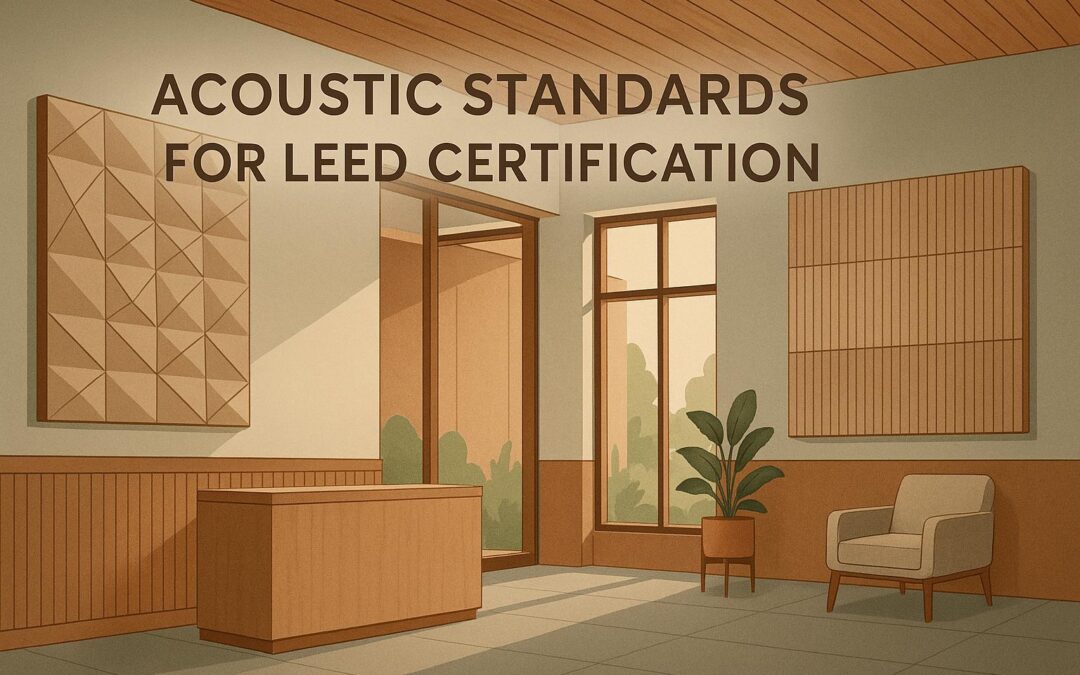Acoustic design is essential for achieving LEED certification, ensuring spaces are comfortable, functional, and meet sustainability goals. LEED v4.1 outlines key acoustic requirements that improve sound quality and occupant well-being. Here’s what you need to know:
- Sound Control: Prevent sound transmission between spaces using enhanced walls, seals, and acoustic materials.
- Background Noise Management: Maintain low noise levels by optimising HVAC systems and isolating noisy equipment.
- Speech Clarity: Reduce echoes and reverberation for better communication in classrooms, offices, and meeting rooms.
- Speech Privacy: Implement sound masking and isolation techniques to protect sensitive conversations.
For specific building types, such as schools, hospitals, and offices, tailored acoustic solutions ensure compliance with LEED standards while improving user experience. Early collaboration with acoustic consultants, structured testing, and clear communication are crucial for success.
Quick Tip: Investing in proper acoustic strategies not only helps with certification but also creates spaces where people can work, learn, and heal effectively.
Acoustics 101: Architectural Strategies for Optimal Acoustic …
LEED Acoustic Requirements

LEED v4.1 provides guidelines aimed at improving sound quality to create comfortable and productive environments. Below are the key acoustic requirements outlined in LEED v4.1.
Sound Control Between Spaces
Controlling sound between different areas is crucial to maintaining privacy and reducing distractions. Depending on the purpose of each space, varying levels of sound isolation are required. This is achieved through enhanced wall designs, careful sealing, and the use of specialised acoustic materials.
Managing Background Noise
Keeping ambient noise at comfortable levels is a priority. LEED standards address noise from mechanical systems, equipment, and external sources. Strategies include optimising HVAC systems, isolating noisy equipment, and implementing noise reduction solutions in the building’s design.
Speech Clarity and Room Acoustics
Good room acoustics are essential for clear communication. Proper acoustic treatments reduce echoes and excessive reverberation, improving speech clarity in spaces like meeting rooms, classrooms, and presentation areas.
Speech Privacy Systems
In spaces where privacy is critical, effective speech privacy measures are necessary. A mix of sound isolation techniques and sound masking systems ensures sensitive conversations remain confidential while maintaining an acoustically balanced environment.
These strategies are supported by professional acoustic testing and consultation, ensuring LEED compliance throughout the building’s lifecycle.
Building-Specific Standards
Different building types need specialised acoustic treatments to comply with LEED standards and UK regulations. Below are examples of how various buildings meet these strict requirements.
Schools and Universities
Schools must maintain acoustic conditions that support effective learning. In the UK, facilities adhering to LEED standards must keep background noise levels below 40 dBA and address external noise exceeding 60 dBA during school hours.
Manchester Grammar School‘s STEM wing serves as a strong example of effective acoustic design:
- Reverberation times: Achieved 0.6 seconds, outperforming BB93’s 0.8-second limit
- Classroom noise levels: Maintained at or below 35 dB LAeq
- Speech clarity: Improved with ceiling tiles boasting an NRC of 0.80 or higher
Hospitals and Medical Centres
Healthcare settings demand precise acoustic management to ensure patient comfort and confidentiality. LEED standards require a sound transmission class (STC) of 50 between patient rooms and corridors, with maximum reverberation times of 0.7 seconds in treatment areas.
"The Royal London Hospital renovation achieved LEED Platinum through phased commissioning, using sound intensity mapping to optimise OR door seals. Post-occupancy surveys showed a 72% improvement in staff noise perception".
Birmingham Children’s Hospital‘s 2022 renovation highlights successful acoustic strategies:
| Area | Requirement | Performance |
|---|---|---|
| Patient Rooms | NC 35 max | NC 30 |
| Treatment Areas | 0.7s RT | 0.6s RT |
| Corridors | 45 dBA | 42 dBA |
Office and Retail Spaces
Commercial spaces require acoustic solutions that balance productivity and comfort. Many UK projects have surpassed LEED benchmarks, as seen in recent developments at Canary Wharf.
The 22 Bishopsgate project in London demonstrated effective acoustic management by:
- Using composite partitions with an STC of 55
- Installing baffles with an NRC of 0.95 for enhanced sound absorption
- Achieving ambient noise levels of 42 dBA through targeted sound masking
Retail spaces also benefit from tailored acoustic solutions. For instance, the Westfield London expansion earned LEED Gold certification by:
- Keeping ambient noise in dining areas at 55 dBA
- Reducing echo decay times to 0.8 seconds with suspended acoustic rafts featuring an NRC of 0.9
Office spaces often adopt hybrid approaches, including:
- Sound masking systems to maintain ambient noise at 42 dBA
- Modular acoustic partitions rated at Rw 52
- Microperforated wall panels with an NRC of 0.85 for better sound control
sbb-itb-06ab728
Meeting LEED Requirements
Partnering with Acoustic Consultants
Get acoustic consultants involved early to address potential challenges and develop practical, cost-conscious solutions. Their input ensures that sound-related considerations are factored into the design from the start. Sound of Silence provides customised acoustic solutions for various spaces – commercial, residential, and industrial – helping to integrate sound strategies directly into building plans. This early collaboration paves the way for thorough testing and smooth teamwork throughout the project.
Testing and Documentation
After consulting with experts, the focus shifts to accurate testing and detailed documentation. Carry out structured acoustic tests, such as those for sound transmission, background noise, reverberation, and speech clarity. These tests help identify and fix problems ahead of the final LEED review. Early testing, combined with clear procedures, ensures that any issues are resolved well before certification.
Clear Team Communication
Strong communication between architects, acoustic consultants, and engineers is key to keeping acoustic strategies on track. Regular updates and collaboration ensure that sound-related plans are smoothly integrated into the project. This approach helps tackle potential problems early, keeping the project on course for success.
Sound Control Methods
Here are some practical approaches to managing and controlling sound effectively.
Modern Soundproofing
Modern soundproofing uses layered materials and advanced designs to tackle both airborne and structure-borne noise. These solutions are applied to walls, floors, ceilings, and absorption elements to create spaces with better acoustics, often meeting LEED standards in the process.
Noise Management Systems
Noise management systems combine sound masking with vibration control to achieve balanced acoustics. They help maintain consistent background noise levels and improve speech clarity in various settings.
In open-plan offices or healthcare facilities, sound masking enhances speech privacy and minimises distractions. Many of these systems are customised by experts to suit specific needs, ensuring a quieter, more productive environment.
Sound of Silence Services

Sound of Silence provides customised acoustic solutions tailored to a wide range of buildings, including those aiming for LEED certification. Their services include:
- Techniques for preserving heritage structures
- Retrofitting soundproofing in older buildings
- Specialised acoustics for cinemas and recording studios
- Bespoke solutions for historic properties
Their work ensures spaces are acoustically optimised while respecting their unique features. For demanding environments like cinemas, studios, and auditoriums, their tailored solutions deliver excellent sound quality while adhering to LEED acoustic requirements.
Conclusion
Acoustic standards play a key role in LEED certification and directly impact the comfort of building occupants. When acoustic design is aligned with LEED requirements, it creates spaces that prioritise both sustainability and the well-being of those who use them.
By addressing sound transmission and improving room acoustics, these standards ensure buildings meet environmental goals while providing comfortable and functional environments. Whether it’s improving speech clarity in schools or ensuring privacy in healthcare facilities, tailored acoustic solutions are essential for meeting diverse needs.
Expert consultation is vital for achieving both LEED certification and optimal acoustic performance. Through professional testing and guidance, buildings can meet sustainability targets while delivering superior sound environments.
As highlighted throughout this guide, acoustic comfort is an integral part of sustainable design. Effective sound control measures, combined with collaboration with acoustic specialists, ensure that projects meet environmental goals without compromising occupant experience.
Investing in acoustic solutions not only ensures compliance but also creates spaces where people can thrive – whether they are working, learning, healing, or living. This approach enhances both performance and overall well-being.
FAQs
How do acoustic standards support LEED certification and improve occupant comfort?
Acoustic standards are essential for achieving LEED certification as they promote healthier and more comfortable indoor environments. By minimising noise pollution and enhancing sound quality, these standards contribute to better occupant well-being and productivity.
Tailored acoustic solutions, such as consulting, soundproofing, and sound masking systems, can help meet these requirements effectively. These solutions are particularly valuable for spaces like offices, cinemas, recording studios, and other environments where sound quality is critical.
What are the acoustic requirements for schools, hospitals, and offices under LEED v4.1?
LEED v4.1 includes specific acoustic requirements tailored to different building types, such as schools, hospitals, and offices, to promote better indoor environmental quality and occupant comfort. These requirements focus on key aspects like sound insulation, background noise levels, and reverberation control.
For schools, the standards emphasise maintaining low background noise and optimising speech intelligibility in classrooms. Hospitals must address patient privacy and comfort by minimising noise from equipment and ensuring proper soundproofing. Offices typically focus on reducing distractions through sound masking and managing noise from adjacent spaces.
For tailored acoustic solutions to meet LEED standards, consider consulting experts like Sound of Silence, who specialise in designing and implementing strategies for diverse environments.
Why is it important to work with acoustic consultants early in the process to meet LEED acoustic standards, and how do they contribute to certification?
Early collaboration with acoustic consultants is crucial for meeting LEED acoustic standards because it ensures that sound-related requirements are integrated into the project from the start. This proactive approach helps identify potential challenges, streamline compliance, and avoid costly redesigns later.
Acoustic consultants play a key role by conducting sound and vibration assessments, recommending design adjustments, and ensuring compliance with LEED criteria. Their expertise ensures that spaces meet the necessary acoustic performance levels, contributing to a quieter, more comfortable environment while supporting the overall certification process.

